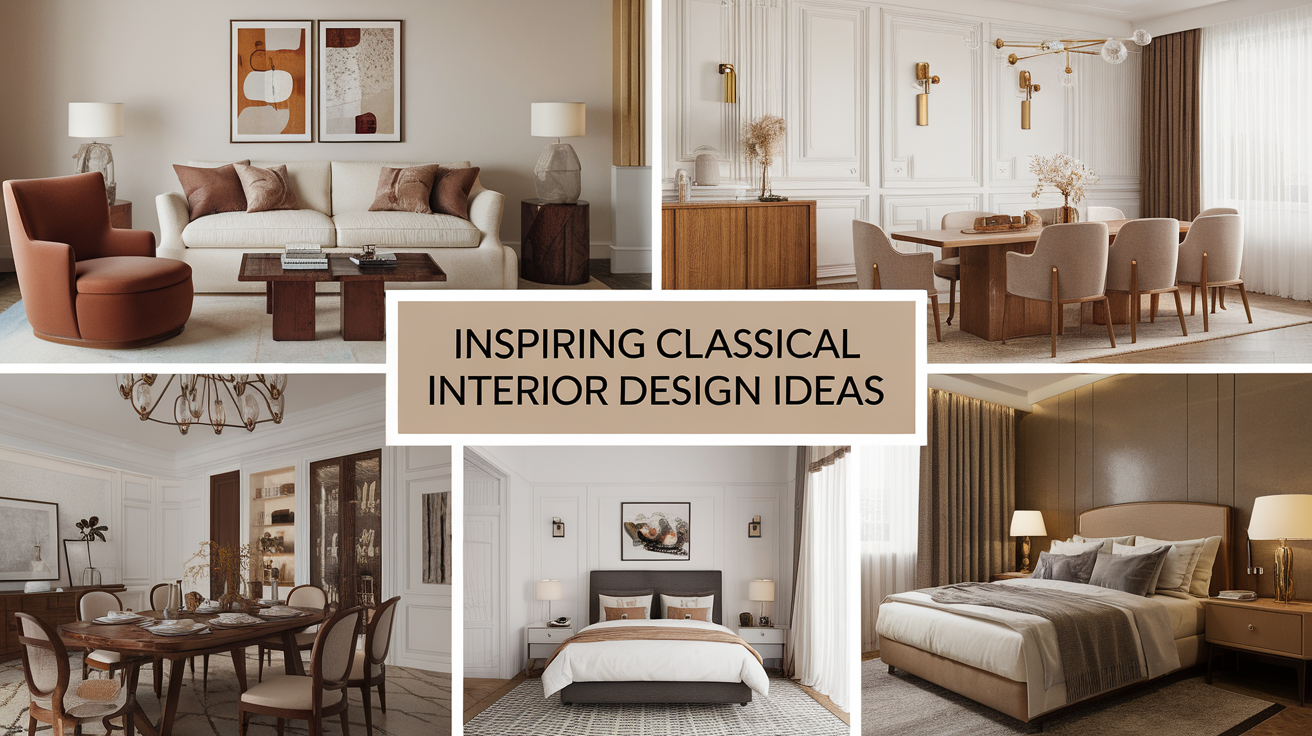Are you dreaming of timeless beauty but unsure how to incorporate classical design into your modern home? You’re not alone. Many homeowners admire the refined beauty of classical interiors but feel overwhelmed by where to start.
In this guide, I’ll share seven approachable classical design ideas that work in real homes—not just in museums or mansions. I’ve used these techniques with dozens of clients to transform ordinary spaces into rooms with lasting character.
As an interior designer with over 15 years of experience, I’ve learned which elements make the biggest impact without requiring a complete renovation or unlimited budget.
If you’re looking to add subtle classical touches or fully embrace traditional design, you’ll find practical ways to incorporate symmetry, proportion, and timeless materials that will elevate your home’s style while still feeling livable and welcoming.
Use of Columns and Architectural Details

Architectural details are the backbone of classical design. They transform ordinary rooms into spaces with presence and character.
I often tell my clients that adding these elements is like giving your home good bones. You don’t need to live in a historic mansion to enjoy their beauty.
Columns and Pilasters
Columns instantly elevate a space. You can use them to:
- Frame doorways or room transitions
- Create separation between open areas
- Add support for archways
- Define special spaces like reading nooks
Don’t have space for full columns? Pilasters (half-columns attached to walls) offer the same classical feel without protruding into your room.
Wall Treatments with Impact
Wall paneling adds texture and dimension that flat walls can’t match. Even simple panel molding creates shadows and visual interest that catches the eye.
I’ve installed wainscoting in countless dining rooms, and the transformation is always dramatic. It provides a perfect backdrop for furniture while adding historical beauty.
Ceiling Details That Wow
Look up! The ceiling offers prime real estate for classical elements.
Crown molding draws the eye upward and creates a finished transition between walls and ceilings. For something more dramatic, ceiling medallions around light fixtures add a touch of grandeur.
These details work especially well in spaces where you entertain or spend time appreciating your surroundings—entryways that welcome guests, dining rooms where conversations linger, or living spaces where you relax and read.
You don’t need to add all these elements at once. Even incorporating just one or two architectural details can dramatically shift your home’s character toward timeless classical design.
Symmetry in Room Layouts
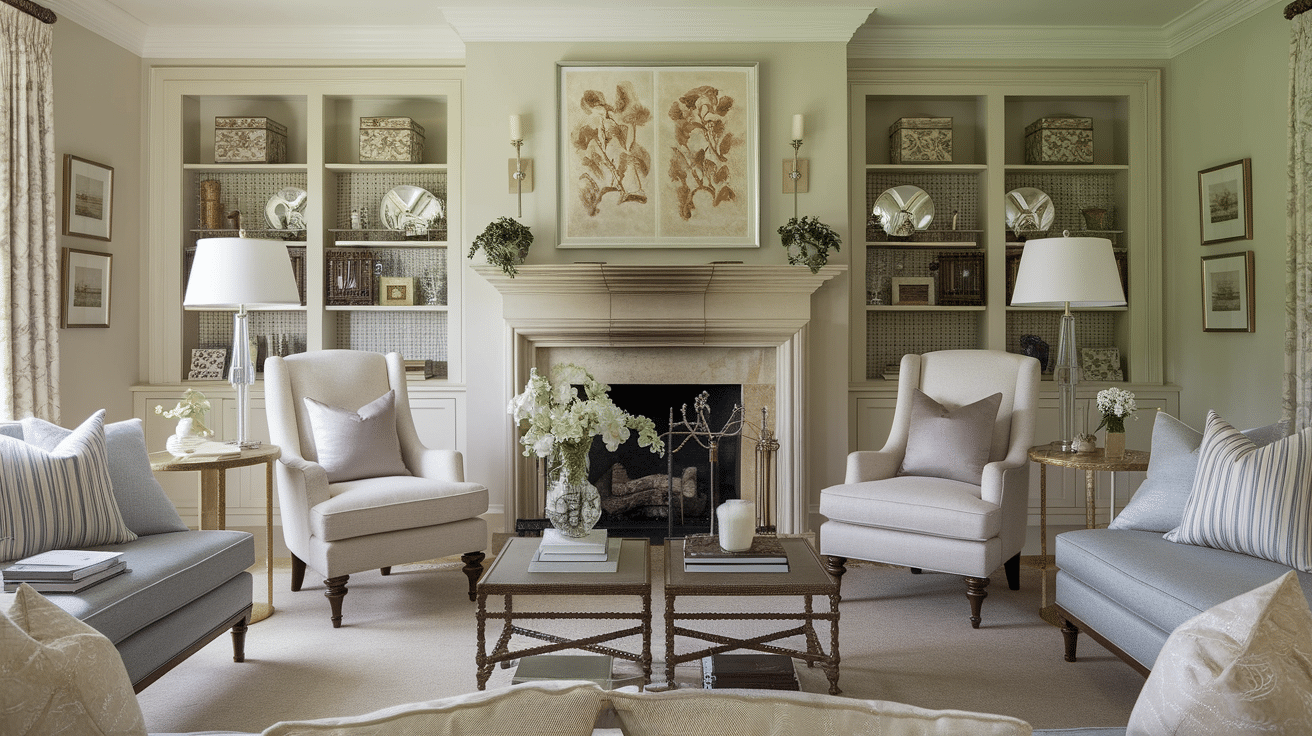
Symmetry is the secret weapon of classical design. It creates instant visual harmony that feels both satisfying and classy.
When I walk into a well-balanced room, I can feel the difference immediately—and so can you. Symmetrical spaces feel intentional and calming, even if you can’t immediately identify why.
Creating Balance with Furniture
The easiest way to bring symmetry into your home is through furniture arrangement:
- Place matching sofas or chairs directly across from each other
- Center larger pieces like beds or dining tables in the room
- Position side tables at equal distances from central elements
- Arrange seating to create conversation areas with balanced proportions
Symmetrical groupings can benefit even asymmetrical rooms. A balanced furniture arrangement brings order to challenging spaces.
The Power of Pairs
Nothing says classical quite like perfect pairs.
Matching lamps, identical end tables, twin chairs flanking a fireplace—these partnerships create visual harmony that feels deeply satisfying. Your eye naturally finds and appreciates these intentional pairings.
Beyond Furniture
Symmetry extends to decorative elements, too:
- Hang artwork at the same height across from each other
- Place matching sconces on either side of a mirror or painting
- Use identical plants or decorative objects on mantels or consoles
- Balance window treatments to frame views evenly
This approach works wonderfully in bedrooms, where symmetry promotes relaxation. In living rooms, it creates formal conversation areas that feel welcoming and well-considered.
You don’t need perfect architectural symmetry to achieve this effect. Even in modern homes with uneven windows or doorways, balanced furniture arrangements can bring classical harmony to any space.
Classical Color Palettes
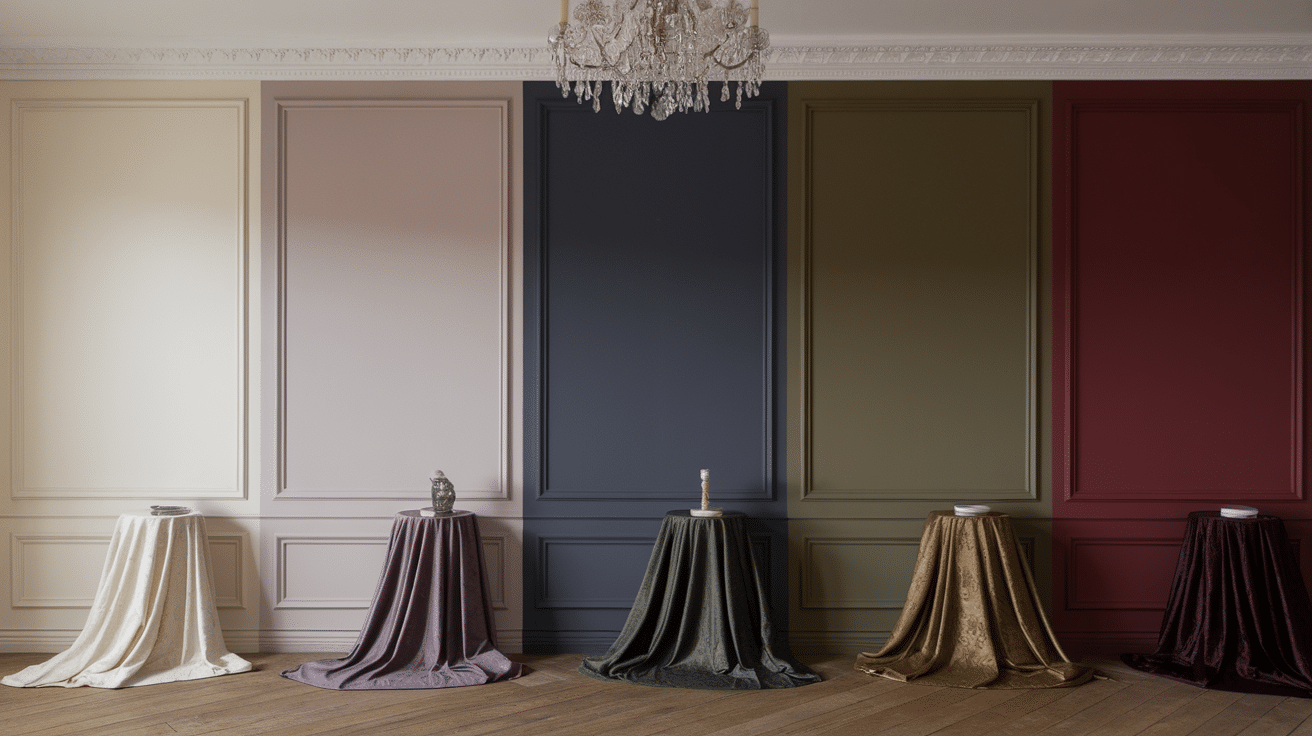
The right colors set the foundation for classical design. Unlike trendy palettes that quickly feel dated, traditional color schemes have stood the test of time for a good reason.
I always recommend starting with a neutral base. These colors create the perfect backdrop for architectural details and fine furniture to shine.
Beautiful Neutrals as Your Canvas
Classical interiors rely on soft neutrals:
- Ivory and cream (warmer than stark white)
- Beige and taupe (for warmth and versatility)
- Soft gray (with either warm or cool undertones)
- Pale blue-gray (almost a neutral but with subtle color)
These colors work so well because they mimic natural materials used in historical buildings, such as limestone, marble, and plaster. They create a sense of permanence and solidity.
Adding Richness with Deeper Colors
Every classical room needs areas of visual weight. I love incorporating deeper, more saturated colors as secondary elements.
These richer hues add substance and character:
- Navy blue (classy and timeless)
- Burgundy or oxblood (traditional without feeling stuffy)
- Olive or sage green (connects to nature while feeling refined)
- Terracotta (warm and earthy)
These colors work beautifully for upholstery, drapery, or accent walls in dining rooms and libraries.
Metallic Accents for Sparkle
No classical scheme is complete without some golden warmth. Metallic finishes add necessary light reflection and luxury:
- Antique gold picture frames
- Bronze lighting fixtures
- Brass hardware on furniture and doors
- Gilded mirror frames
The key is using these metals in a way that looks gently aged rather than shiny and new. I find that antique or brushed finishes integrate most naturally with classical design.
Remember that classical color schemes should feel coordinated but not matched perfectly. The best rooms have subtle variations that create depth and interest while maintaining harmony.
Traditional Furniture Styles
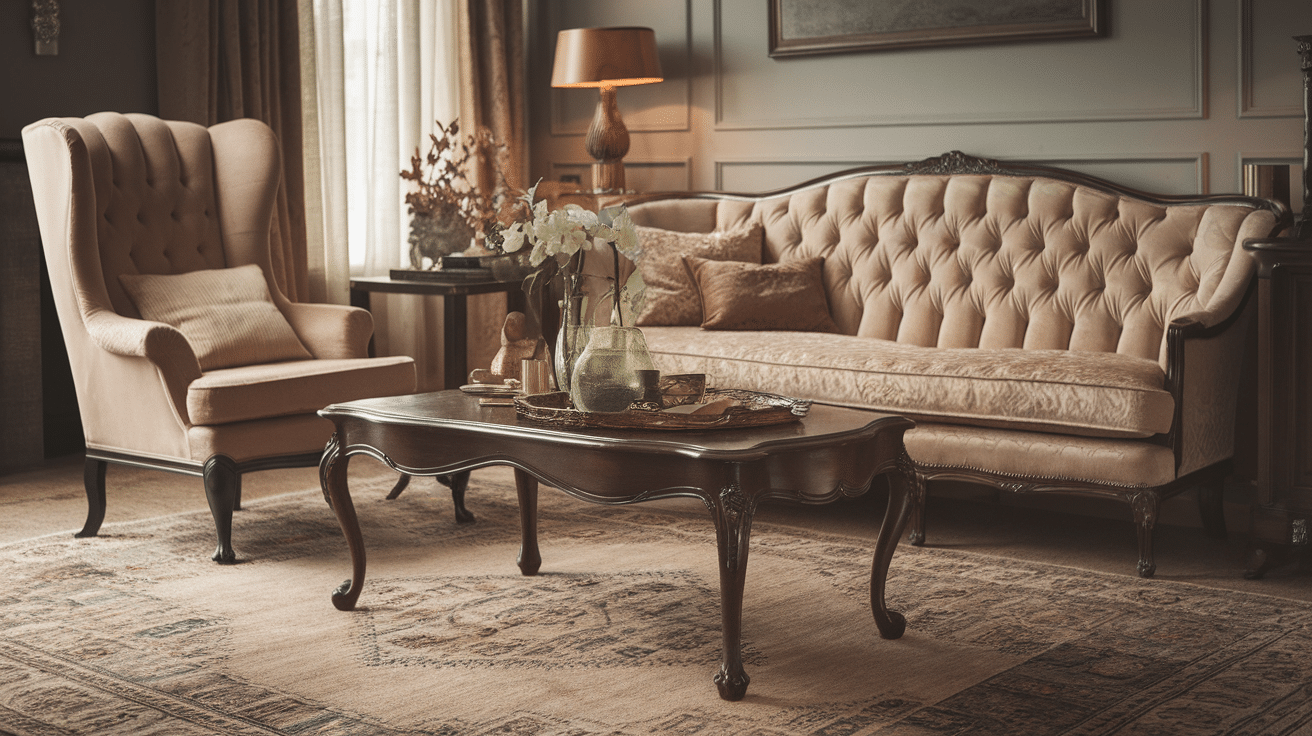
Furniture is the heart of classical design. The right pieces instantly communicate elegance and permanence.
I’ve found that truly timeless rooms feature furniture with historical roots but practical everyday function. You don’t need to fill your home with museum-quality antiques to capture the classical style.
Iconic Shapes with Staying Power
Look for these distinctive silhouettes that have remained popular for centuries:
- Wingback chairs (perfect for creating cozy reading nooks)
- Tufted sofas with rolled arms (classy but comfortable)
- Furniture with cabriole legs (the curved legs seen on quality pieces)
- Pedestal dining tables (more graceful than four-legged tables)
- Four-poster or canopy beds (add drama to bedroom spaces)
These shapes have endured because they combine beauty with function. I always tell clients to invest in one or two anchor pieces with classical lines, even if the rest of their furniture is more contemporary.
The Warmth of Dark Woods
Wood choice dramatically impacts a room’s classical feel. Rich, dark woods create instant gravitas:
- Mahogany (with its reddish-brown depth)
- Walnut (slightly darker with beautiful grain patterns)
- Cherry (which develops a deep patina over time)
Even if you prefer a lighter overall look, incorporating one or two darker wood pieces adds necessary visual weight and authenticity to classical spaces.
Upholstery That Enhances
The fabric you choose for seating makes an enormous difference:
- Subtle damasks or small-scale patterns feel timeless
- Velvet adds luxurious texture without seeming fussy
- Linen in neutral tones offers casual elegance
- Leather (especially in cognac or oxblood) ages beautifully
I recommend choosing upholstery that feels special but not delicate. The best classical rooms are beautiful but still livable—never so precious that you’re afraid to use the furniture.
Antique and Ornate Mirrors
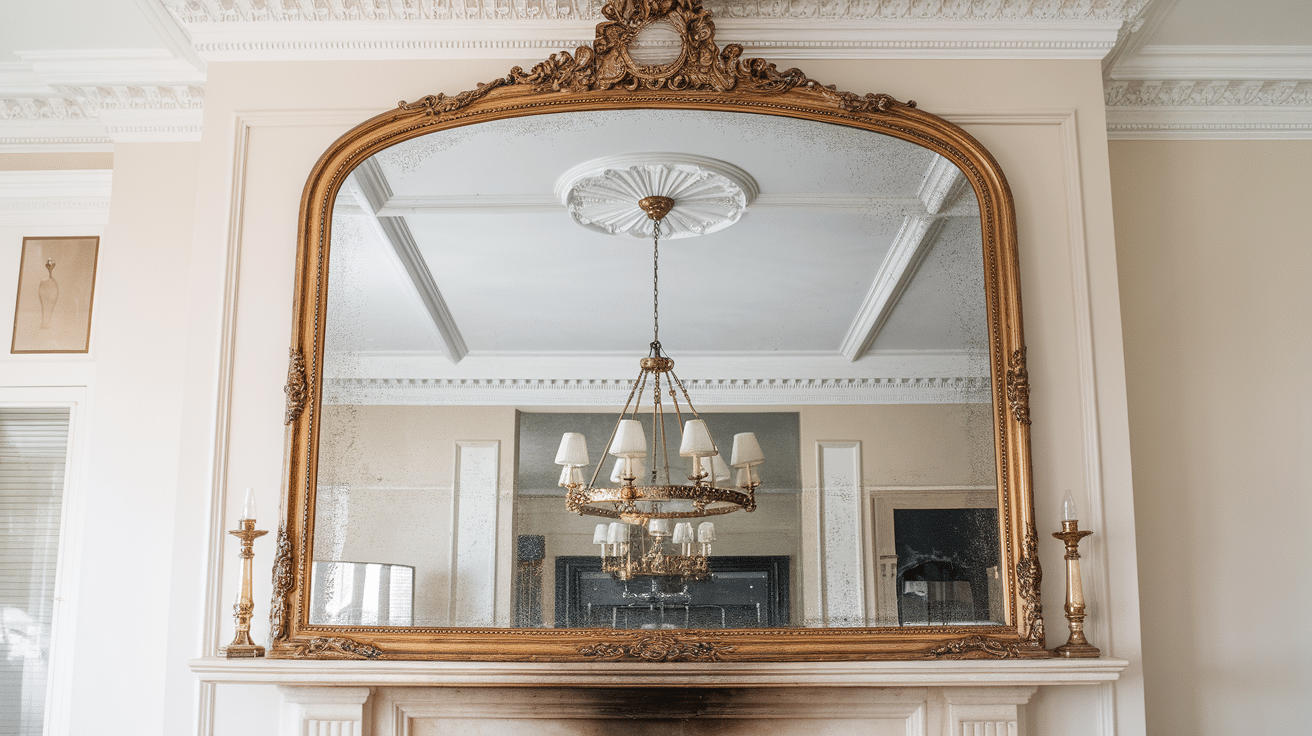
A well-placed mirror is transformative in classical design. Not just functional items, mirrors become architectural elements that expand your space visually and add instant character.
When I redesign a room with classical elements, I always look for opportunities to incorporate statement mirrors. They’re like windows where you need them most.
Choosing Mirrors with Presence
- Gold or gilt frames bring warmth and traditional elegance
- Carved wood frames add texture and craftsmanship
- Beveled glass edges catch the light beautifully
- Antiqued or foxed glass surfaces create depth and age
The right mirror should command attention while performing its practical function. Vintage-inspired pieces often have more character than new ones, even if they’re not true antiques.
Strategic Placement for Maximum Impact
Where you hang your mirror matters as much as the mirror itself and consider these classic locations:
- Above a fireplace (creating a natural focal point)
- In your entryway (for last-minute checks and to expand the space)
- Behind a dining table (to reflect candlelight during dinner parties)
- At the end of a hallway (to visually extend the space)
- Across from windows (to bounce natural light throughout the room)
A mirror placed opposite your most beautiful room feature will double its visual impact—whether that’s a chandelier, artwork, or architectural detail.
Beyond Decoration
Mirrors in classical design work harder than just looking pretty. They:
- Amplify natural light in darker spaces
- Reinforce symmetrical arrangements
- Create the illusion of more space
- Reflect beautiful views or artwork
- Add a sense of history and permanence
With just the right mirror placement, I’ve transformed small, dark rooms into bright, expansive-feeling spaces. Few decorative elements offer this much practical benefit while adding such strong classical character.
Classical Artwork and Accessories
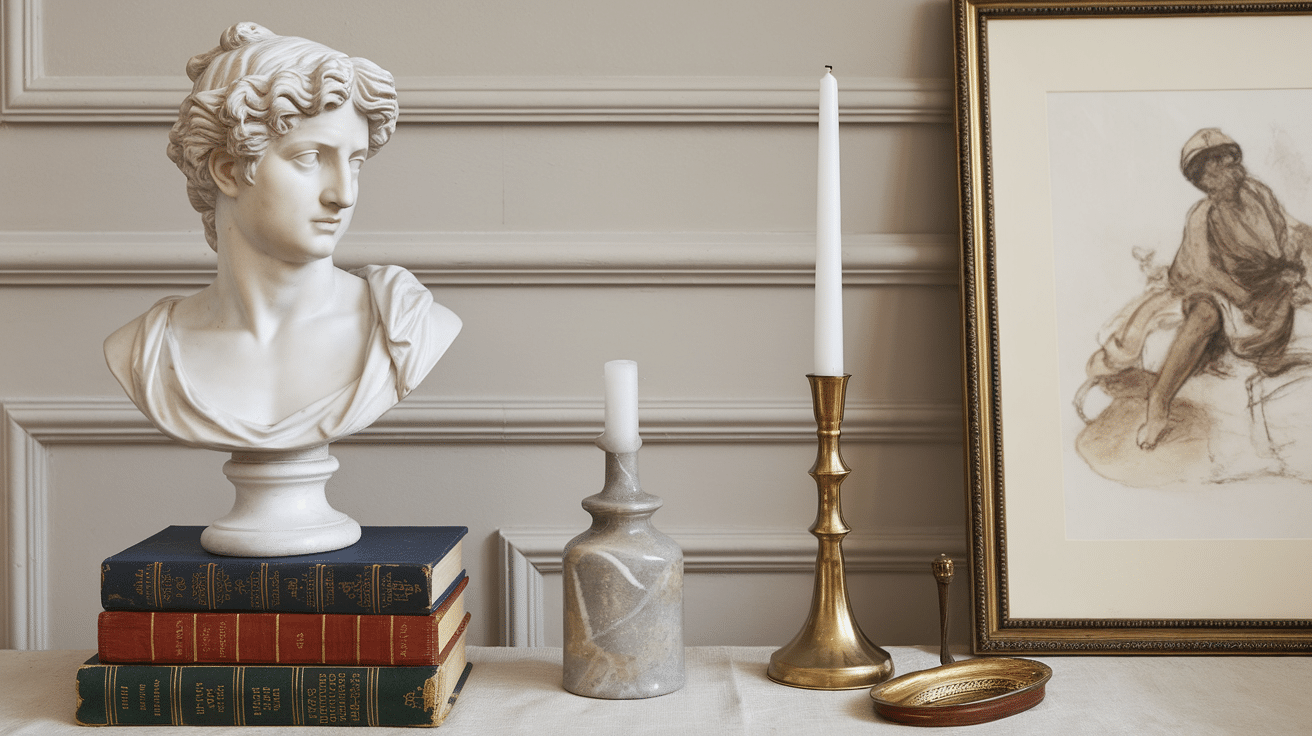
Accessories breathe life into classical spaces. They transform a well-designed room into one that feels personally meaningful and truly finished.
I always tell my clients that accessories are where you can express yourself while still honoring classical principles. This is where your space becomes uniquely yours.
Artwork with Timeless Appeal
Classical rooms shine with these traditional art forms:
- Oil paintings in gilded frames (landscapes or portraits work beautifully)
- Framed architectural sketches or botanical prints
- Sculptural elements like busts or reliefs
- Antique maps or historical engravings
You don’t need museum-quality pieces to create impact. I’ve found beautiful reproductions that capture classical style without the high price tag of originals.
Layering with Decorative Objects
The best classic rooms feel collected over time, not purchased all at once and consider these elements to create depth:
- Ceramic urns or ginger jars in blue and white
- Crystal or brass candlesticks of varying heights
- Leather-bound books or hardcovers with beautiful spines
- Small sculptures or decorative boxes on tabletops
These items should feel purposeful, not random. Each piece should earn its place through beauty, meaning, or function.
The Art of Restraint
Less truly is more in classical design. I always emphasize:
- Leave breathing room between objects
- Group items in odd numbers (usually threes)
- Vary heights and textures within groupings
- Choose fewer, higher-quality pieces over many cheaper ones
This curated approach prevents the classical style from tipping into cluttered or stuffy territory. Your eye needs places to rest between points of interest.
The accessories you choose should tell your story while respecting classic beauty. When these elements come together thoughtfully, they create rooms that feel both timeless and deeply personal.
Beautiful Window Treatments
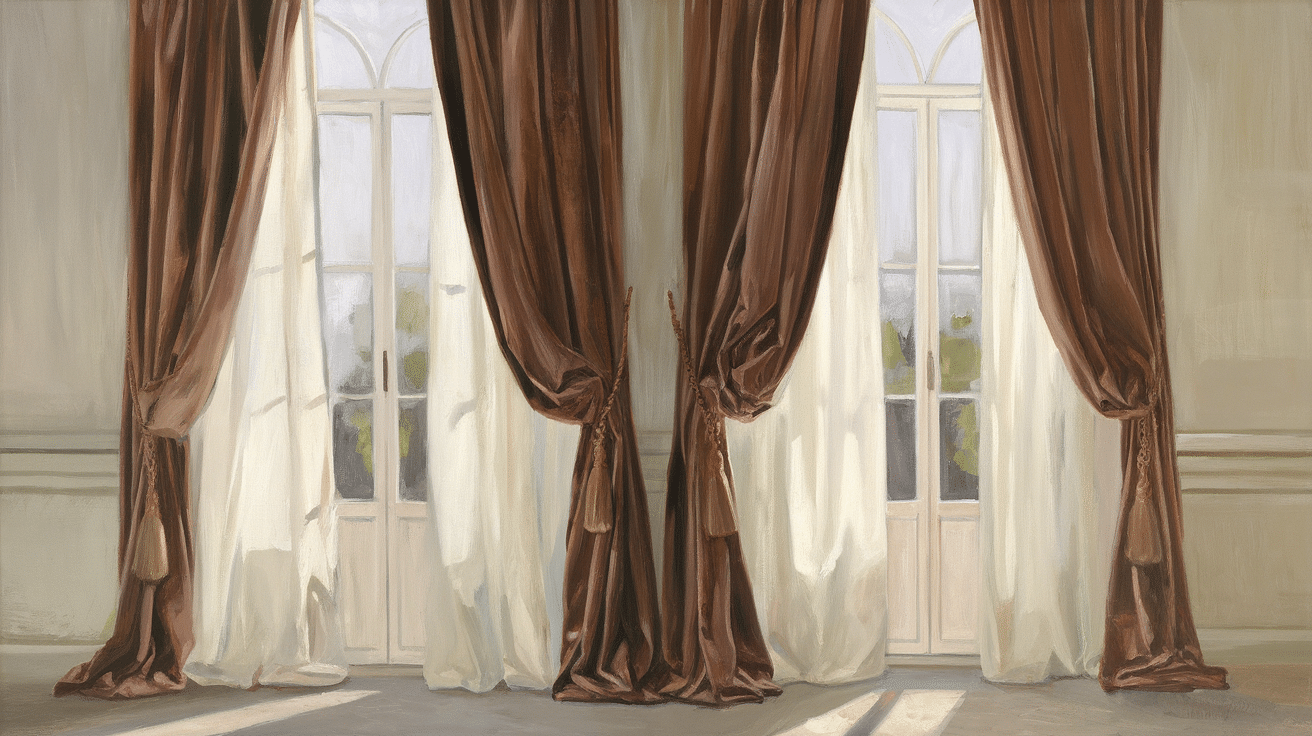
Window treatments are the jewelry of classic rooms. They frame your views, filter light beautifully, and add essential softness to spaces with architectural details.
I’ve seen modest rooms completely transformed by the right drapery. Few elements make as much impact on a room’s overall feeling.
The Power of Floor-Length Fabrics
Classical windows demand proper proportions:
- Drapes that touch the floor (or “puddle” slightly for added luxury)
- Panels hung high above the window frame to create height
- Sufficient fullness for beautiful folds and proper movement
- Substantial fabrics that hold their shape
I always recommend mounting curtain rods near the ceiling rather than just above the window. This simple change makes ceilings appear higher and windows more grand.
Fabrics That Feel Luxurious
The fabric you choose sets the tone for the entire room. You can consider these classic options:
- Velvet for drama and sound absorption (perfect for formal living spaces)
- Silk for luminous beauty and elegance (though less practical for everyday use)
- Linen for a more casual but still refined appearance
- Damask patterns for subtle texture and interest
These materials interact with light differently throughout the day, adding visual interest as natural light changes.
Layering for Sophistication
The most beautiful windows often feature thoughtful layering:
- Sheers beneath heavier drapes filter harsh sunlight
- Roman shades paired with side panels offer flexibility
- Valances or cornices add architectural interest to the window top
- Decorative hardware like finials and tiebacks becomes part of the design
I find that layered treatments allow for both privacy and light control while offering the most complete classical look.
Remember that classic window treatments should appear generous without being overwhelming. The goal is framing your views and adding softness—not covering beautiful architecture or blocking natural light.
Conclusion
Classical design endures for good reason. Its emphasis on proportion, symmetry, and timeless materials creates spaces that feel both impressive and comforting.
By incorporating these seven elements—architectural details, symmetrical layouts, traditional color palettes, classic furniture, ornate mirrors, curated accessories, and window treatments—you can bring classical elegance into any home, regardless of its age or architecture.
Remember that true classical design isn’t about recreating museum rooms or period-perfect spaces. It’s about borrowing the best principles from the past while creating homes that work for modern life.
Start small by implementing one or two ideas that resonate most with you. Perhaps add crown molding to your dining room or replace a coffee table with one featuring cabriole legs. Even modest changes can shift your home’s atmosphere toward timeless beauty.
Classical design isn’t just beautiful—it’s a proven approach that never goes out of style.
Frequently Asked Questions
Can I Incorporate Classical Design in A New-Build Home without Architectural Details?
Absolutely! While older homes may have built-in classical elements, you can add architectural details to any space. Start with crown molding, add applied molding to create wall panels, and incorporate substantial baseboards.
These additions make the framework for classical design and can be installed in any home regardless of age.
How Do I Prevent Classical Design from Feeling Stuffy or Outdated?
Balance is key. Mix in some contemporary elements like modern lighting or abstract art. Keep your color palette fresh rather than muddy, and avoid overcrowding rooms with too many accessories.
Classical design should feel dignified but still livable—not like a museum where nothing can be touched.
Is Classical Design More Expensive to Implement than Other Styles?
Not necessarily. While true antiques can be costly, many manufacturers offer beautiful reproductions at various price points.
Start with key pieces and architectural elements, then add accessories over time. Quality classical pieces often retain their value better than trendy items, making them wise investments for the long term.
Can Classical Design Work in Small Spaces?
Classical principles work wonderfully in smaller rooms. Use appropriately scaled furniture (many antiques were designed for smaller spaces), leverage mirrors to expand visual space, and maintain symmetry to create order.
Just be careful not to overcrowd the room—in small spaces, each piece should be both beautiful and functional.
How Can I Make Classical Design Feel More Casual and Family-Friendly?
Choose performance fabrics in traditional patterns for upholstery, opt for distressed wood finishes that hide marks, and incorporate natural elements like plants.
Focus on the classical principles of balance and proportion while selecting more casual materials. Remember that many classical homes throughout history were actually family homes, not just formal showplaces.

